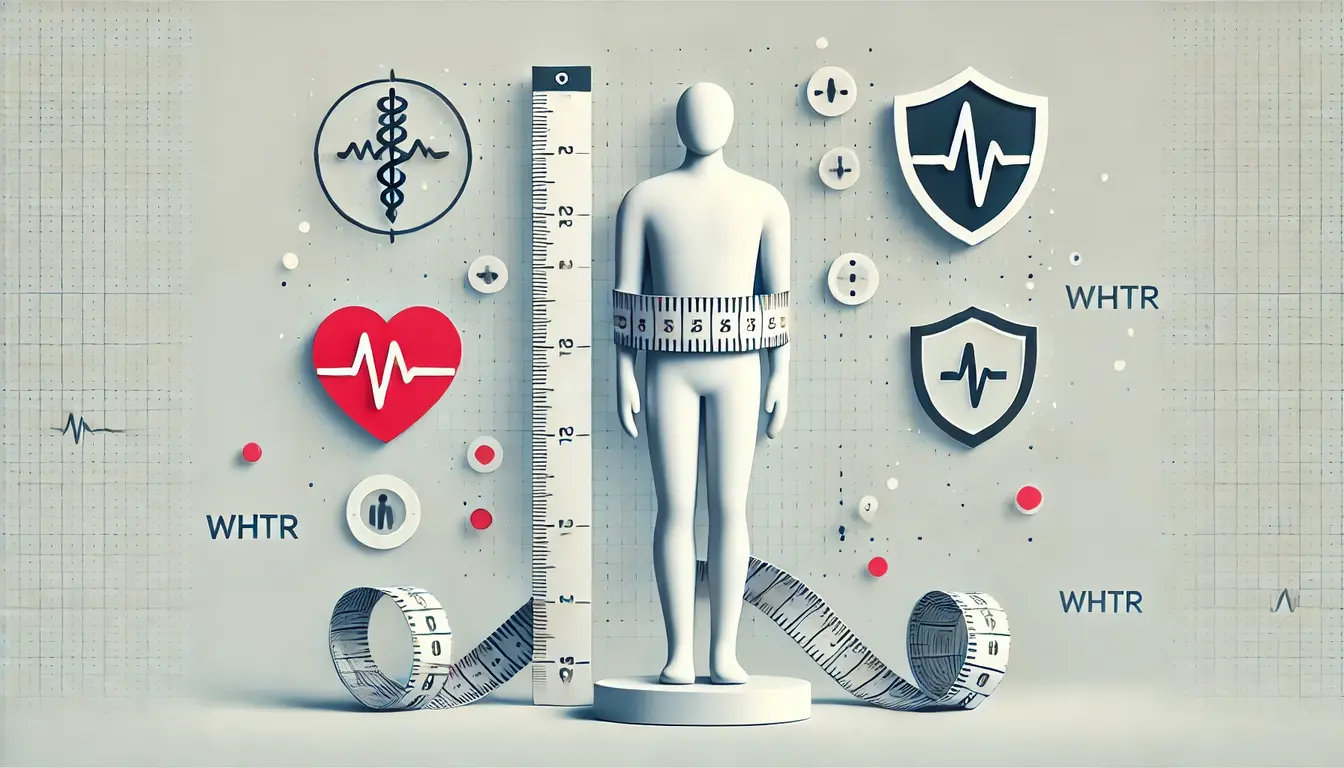For many years, doctors and health experts have used a number called Body Mass Index (BMI) to figure out if someone is at a healthy weight. But now, more and more researchers are saying there’s something even better to look at—your Waist-to-Height Ratio (WHtR). This simple measurement might actually give you a clearer picture of your health than BMI ever could.
Here’s why it matters: BMI only compares your weight to your height. It doesn’t show where your body stores fat. WHtR, on the other hand, tells you if you’re carrying too much fat around your waist—and that’s a big deal. Belly fat is more dangerous than most people think. It’s linked to serious health problems like heart disease, diabetes, high blood pressure, and even early death.
So, instead of just focusing on what the scale says or what your BMI number is, it may be time to start paying closer attention to your waist size compared to your height. It’s a small change that could give you a much better idea of your true health.

What is Waist-to-Height Ratio (WHtR)?
Your waist-to-height ratio is simple to calculate. Just take a measuring tape, measure your waist, and divide it by your height (use the same units for both).
WHtR = Waist ÷ Height
If your WHtR is less than 0.5, you’re likely in the healthy range. If it’s above 0.5, you could be at higher risk for health problems—even if your BMI is “normal.”
Why WHtR is Better than BMI
- The focus is on belly fat, also known as visceral fat, which is considered more dangerous.
- It works across all ages, genders, and ethnic groups without the need for special charts.
- It predicts health risks more accurately than BMI.
- It is easier to understand and calculate with just a measuring tape.
Health Risks Linked to High Waist-to-Height Ratio
Let’s dive deeper into why WHtR matters so much. Here’s how it affects your health:
1. Heart Problems and High Blood Pressure
Studies indicate that people with a high WHtR are more likely to have heart attacks, strokes, and hypertension. One large study with over 300,000 people found that WHtR was better than BMI at predicting heart disease.
2. Risk of Type 2 Diabetes
Belly fat affects how your body uses insulin, which can lead to insulin resistance. This raises your chance of developing type 2 diabetes, even if your weight seems normal on the BMI scale.
3. Higher Risk of Death
Shocking but true: People with normal BMI but high WHtR still had a greater risk of dying earlier compared to those with low WHtR. This finding underscores the importance of examining the storage of fat rather than solely focusing on total weight.
4. Metabolic Syndrome
A metabolic disorder is a group of conditions like high blood sugar, high cholesterol, and belly fat that raise the risk of serious diseases. WHtR helps detect these problems earlier so you can take action.

What Causes a High Waist-to-Height Ratio?
Understanding the reasons behind a high WHtR can help you make healthier choices. Here are common causes:
- Poor diet: High-calorie diets that are rich in sugars and fats can lead to weight gain, especially in the abdominal area.
- Lack of exercise: A lack of physical activity is a major factor contributing to obesity and the accumulation of central body fat.
- Genetics: Genetic predisposition can affect how body fat is distributed and how metabolism functions, which in turn influences the waist-to-height ratio (WHtR).
- Aging: As we age, metabolism slows down, and fat often shifts toward the belly area.
- Hormonal changes: Hormonal changes, especially during menopause, can increase abdominal fat.
How to Prevent a High WHtR
Want to keep your waist in check? Here’s how to stop belly fat before it becomes a problem:
1. Eat a Balanced Diet
Choose fruits, vegetables, whole grains, and lean proteins. Stay away from junk food, processed snacks, and sugary beverages.
2. Stay Active
To reduce belly fat, engage in exercises like walking, jogging, cycling, or dancing, and incorporate some strength training as well!
3. Practice Mindful Eating
Eat slowly and pay attention to your fullness cues. Avoid eating while watching TV or scrolling on your phone.
4. Reduce Stress
Stress can lead to the accumulation of belly fat. Consider practicing yoga, deep breathing, or meditation to help relax both your body and mind.
5. Get Enough Sleep
Aim for 7 to 9 hours of sleep each night, as lack of sleep disrupts hormones and makes weight loss more difficult.
Tips to Lower Your Waist-to-Height Ratio Naturally
Making simple changes to your diet and lifestyle can have a significant impact.
1. Add More Fiber
Foods such as beans, oats, apples, and carrots are effective for keeping you feeling full and supporting digestion.
2. Choose Whole Grains
Replace white bread and rice with whole wheat bread, brown rice, and quinoa, as they help you feel fuller for longer.
3. Drink More Water
Water helps regulate hunger. If plain water seems boring, add a slice of lemon or some fruit.
4. Eat Healthy Fats
Avoid butter and fried foods. Instead, opt for healthier alternatives like olive oil, nuts, avocados, and fatty fish.
5. Eat Smaller Meals More Often
Try smaller, more frequent meals instead of three big ones. The practice keeps your energy steady and reduces cravings.
6. Load Up on Vegetables
Fill half your plate with various colorful vegetables. They are low in calories and packed with nutrients.
7. Cut Down on Sugar
Say no to sugary snacks and soda. Opt for healthier alternatives like fruits or homemade smoothies.
8. Watch Your Portions
Try using smaller plates and bowls when you eat. This simple change can make you eat less food while still feeling satisfied.
How to Track and Manage Your WHtR
1. Measure Regularly
Measure your waist and height every few weeks to track progress and stay motivated.
2. Set Realistic Goals
Small goals lead to significant results. Focus on losing inches from your waist, not just pounds on the scale.
3. Get Professional Help
Consult a doctor, nutritionist, or fitness coach to create a personalized plan.
4. Join a Community
You can stay motivated and on track by joining online forums, workout partners, or support groups.
5. Stay Informed
Gaining knowledge about WHtR enables you to make more informed decisions. Share what you learn with your family and friends!

Waist-to-Height Ratio vs BMI: Which is Better?
Let’s compare them side by side:
| Feature | BMI | WHtR |
| Measures | Total body weight | Belly fat (central obesity) |
| Accuracy | May mislabel fit people as overweight | Better for health risk prediction |
| Age/Gender Adjustments | Needed | Not needed |
| Predicts Health Risks | Less reliable | More accurate |
| Easy to Calculate | Yes | Yes |
Final Verdict? WHtR Wins.
Waist-to-Height Ratio is more reliable, more accurate, and easier to use. Health experts around the world are now recommending it over BMI to assess real health risks.
Conclusion: Small Waist, Big Health Impact
Your health is not solely determined by your weight; the distribution of your body fat plays a significant role as well. Calculating your waist-to-height ratio can provide you with a clear understanding of the health risks you may face, particularly those related to abdominal fat. By making small changes to your diet, leading an active lifestyle, and regularly monitoring your measurements, you can take control of your health.
So, the next time you consider your health goals, think about using a measuring tape instead of relying solely on the scale. Your waistline could potentially play a crucial role in your well-being.
FAQ
What is the waist-to-height ratio, and why is it important?
WHtR is a health measure comparing your waist size to your height. It’s a strong indicator of health risks like heart disease and diabetes.
Is waist-to-height ratio more accurate than BMI?
Yes. WHtR reveals the storage of fat, particularly around the belly, while BMI does not. It’s better at predicting health issues.
What is a healthy waist-to-height ratio?
A WHtR below 0.5 is considered healthy for both men and women. Anything higher may increase your risk of health problems.
How do I measure my WHtR at home?
Use a measuring tape to measure your waist and divide it by your height. Make sure both are in the same units (inches or centimeters).
Can I improve my WHtR with lifestyle changes?
Yes! Eating a balanced diet, staying active, reducing stress, and getting enough sleep can help lower your WHtR naturally.






